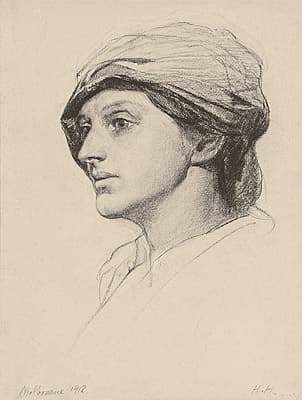Hans
HEYSEN
Germany
1877
–
Australia
1968
Australia from 1884; Europe, England 1899-1903
Sallie (The artist's wife)
1912
charcoal on paper
Frame
62.2 (h)
x 50.0 (w)
x 4.0 (d)
cm
Private Collection
Drawing has been described as the most intimate of all the arts. When the subject of a drawing is someone close to the artist, it follows that the drawing can express the qualities of the subject with a particular sensitivity. Hans Heysen’s charcoal portrait of his wife, Sallie, was drawn in Melbourne in 1912 and captures the sitter at a pivotal moment in the couple’s life. They had travelled to Melbourne for Heysen’s solo exhibition of watercolours at the Athenæum Hall, having just made a deposit on their first home, The Cedars in the Adelaide Hills near Hahndorf; the purchase depended on the success of the exhibition. Married to Heysen in 1904, Sallie had already had four of their eight children when this portrait was made.
Born Selma Bartels, Sallie, as she was known, was the daughter in a well-respected Adelaide family, prominent in the German community. Her father, Adolph Heinrich Friedrich Bartels had twice been mayor of Adelaide, in 1871 and 1872. Interested in the theatre and art, Sallie became acquainted with Heysen on a drawing expedition of private students that he led to Victor Harbour in January 1904.
The portrait captures Sallie’s elegant features in profile, her face dominated by large, intelligent eyes. With a sure, steady hand, Heysen uses his medium to optimum effect, modelling the head in profile with [soft tonal gradations]. Eschewing the use of a stump to create areas of tone, Heysen preferred to smudge the charcoal with his fingers to achieve subtle tonal gradations.[1] This technique sensitively registers the gesture on the textured surface of the paper. The power of drawing lies in the resonance of this act—the making of the drawing parallels the touch of a caress. The portrait stands as a personal record of Sallie’s luminous presence at a time of singular importance. Her gaze, directed outwards and away from her husband, conveys a sense of anticipation of a new beginning, which the success of Heysen’s exhibition promised.
Maria Zagala
[1] Alison Carroll, ‘Heysen the draughtsman’, in Ian North, Hans Heysen centenary retrospective, Art Gallery Board of South Australia, Adelaide, 1977, p 73
© Art Gallery of South Australia, Adelaide, 2008
Andrews, Hans Heysen, exhibition book, Art Gallery of South Australia, Adelaide, 2008, p 48
